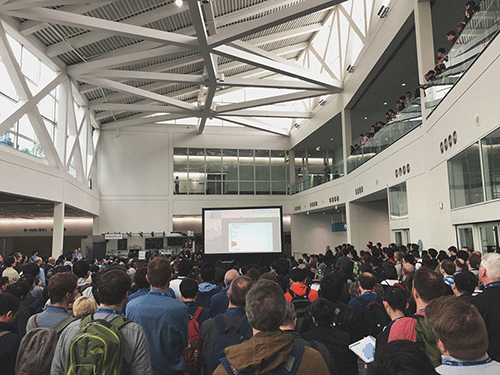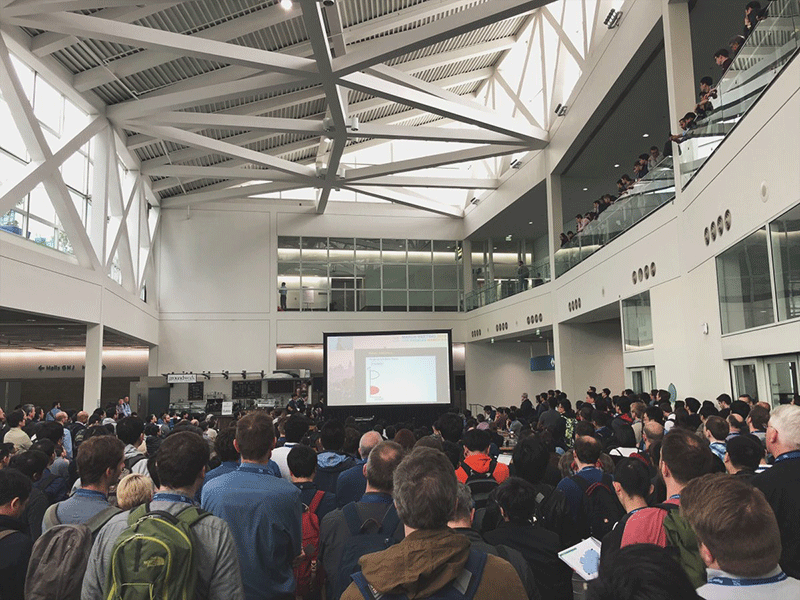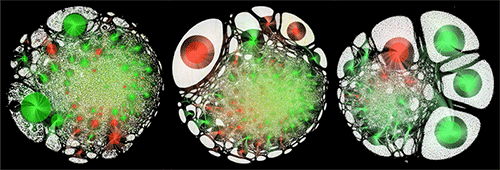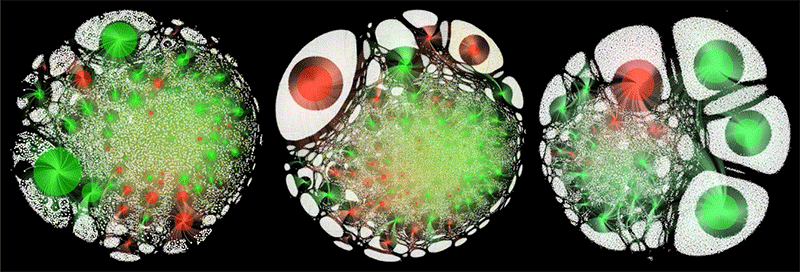Meetings: Scenes from the 2018 APS March Meeting
With just over 11,300 attendees, this year’s March Meeting of the American Physical Society in Los Angeles was the largest on record. Judging from the list of most scheduled talks, the conference’s starring topics were topological qubits, quantum computing, and machine learning. Lucky attendees may have also enjoyed a slice of birthday cake at the “Meet the Editors” social, where editors kicked off a yearlong celebration of the Physical Review’s 125th anniversary.
Here’s a sampling of the news we heard at talks and in the press room.
–Matteo Rini and Katherine Wright
Turning on superconductivity in graphene. Making a splash, Pablo Jarillo-Herrero of the Massachusetts Institute of Technology reported that it’s possible to create superconductivity in two stacked layers of graphene by rotating one layer with respect to the other. Jarillo-Herrero explained that the observed form of superconductivity is reminiscent of that in high-temperature superconductors. The system can also be tuned to behave as either an insulator or a superconductor simply by adjusting an applied electric field. These features could make it much easier to study the mechanisms behind high-temperature superconductivity, which are still mysterious.
A $200 electron microscope. Manu Prakash of Stanford University likes to imagine a world where technology is cheap enough for everyone to do science. Speaking at the popular Kavli symposium, Prakash described Foldscope, a microscope made of paper that offers 140X magnification but costs only $1 to make. The microscope is now in the hands of 400,000 people around the world. Having also created a paper-based centrifuge, Prakash’s next plan is to develop an electron microscope for under $200—about 10,000 times less than the usual price.
Is quantum supremacy in sight? The presence of major players in academia and industry electrified sessions on quantum information. Google stole the spotlight with its announcement of Bristlecone—a quantum computer with a record number of qubits (72) arranged like scales in a pinecone. Researchers at Google have yet to test the error rate with which the device can perform quantum logical operations, a critical figure of merit. But they exuded confidence that Bristlecone would be the first device to reach “quantum supremacy” over classical machines.
Modeling the spread of terrorism in social networks. Neil Johnson of the University of Miami has harnessed several physics tools—many-body theory, complex network models, and Feynman diagrams—to analyze the online presence of ISIS. Using data from a Russian social media platform called Vkontakte, Johnson found that the terrorist organization’s network of online supporters has evolved like an aging brain, even acquiring disfunctional features reminiscent of Alzheimer’s disease. The U.S. Department of Defense is funding his research, hoping that it will lead to useful tools to monitor and target extremism.
Why teeth don’t crack. Each chomp on a sandwich exerts up to a 1000 N of force on your teeth, so how can the pearly whites survive a lifetime of eating? Pupa Gilbert of the University of Wisconsin–Madison explained that teeth owe their incredible strength to the misalignment of the microscopic crystals in dental enamel. She and her colleagues made this surprising discovery by mapping the crystals’ orientations with a polarized-x-ray imaging technique. The misalignment prevents cracks from propagating more than a few tens of nanometers, she explained.
Majorana zero modes. Continuing on the theme of qubits, Sankar Das Sarma of the University of Maryland gave an overview talk about quasiparticles called majorana zero modes (MZMs). These states could be the basis for topological qubits, which are thought to be particularly resistant to environmental noise. Six research groups claim to have detected MZMs in various materials, but Das Sarma, who predicted the existence of MZMs in 2005, is skeptical. He said it’s possible that the quasiparticles have been seen, “but we cannot prove that.”
Red light puts a stop to sticky algae. Algae is a persistent but unwelcome guest in bioreactors. To get rid of it, Oliver Bäumchen of the Max Planck Institute for Dynamics and Self-Organization suggests turning on red light. He showed that the surface adhesion of Chlamydomonas microalgae varies with the color of light, turning on for blue and off for red. Baümchen said that this switching effect likely arises because light redistributes adhesion-promoting proteins in the organism’s flagella. The organism can also switch into or out of its sticky state in seconds.
The latest on cold-atom supersolids. Supersolidity—a bizarre phenomenon in which a crystal flows like a liquid with zero viscosity—has yet to be seen in a material. But in 2017, two research teams did succeed in creating the exotic phase in ultracold gases. At a session devoted to the topic, Andrea Morales of the Swiss Federal Institute of Technology (ETH) in Zurich, a member of one of the discovery teams, described new experiments showing that two distinct supersolid phases can coexist, couple, and compete with one another in the same gas. These experiments might provide insight into materials like multiferroics and superconductors, whose properties are thought to arise from competing phases.
Moondance. What’s it like to boogie on the moon? Physics and dance major Justine Walker of the College of Wooster combined her two passions to find out. Presenting at a session on undergraduate research, Walker described how she’d harnessed a dancer to a system of counterweights and pulled her upwards to mimic the effects of reduced gravity. A video that Walker posted on twitter shows that a dancer’s steps turn into skips and hops, and that dancing on your toes is a lot easier on the moon.
A journal with a superhero twist. Batman and Wonder Woman not only protect citizens, they might also teach you some physics. Theoretical physicist Barry Fitzgerald of the Delft University of Technology uses stories about superheroes, supervillains, and superpowers to communicate with the public. Now he’s launched a journal for manuscipts in which scientists are asked to exploit the “superhero genre” to present their research. The open-access, peer-reviewed journal, called “Superhero Science and Technology,” is open for submissions.







